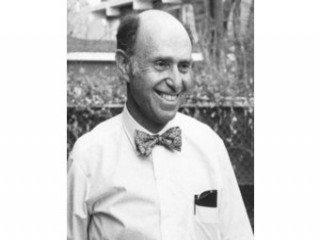
Theodore Puck biography
Date of birth : 1916-09-24
Date of death : 2005-11-06
Birthplace : Chicago, Illinois, United States
Nationality : American
Category : Science and Technology
Last modified : 2011-09-09
Credited as : geneticist, cloning,
0 votes so far
Puck was born in 1916 in Chicago, Illinois. In 1937, he earned an undergraduate degree in physical chemistry from the University of Chicago, following up with a doctoral degree in 1940 from the same university. During the mid-1940s at the height of U.S. involvement in World War II he studied airborne infections as part of an army commission. In 1948, Puck joined the University of Colorado Medical School, where he remained on the faculty until his death. He also served as chairman of the biophysics department from 1948 to 1967.
At the time Puck embarked on his research career in the 1940s, scientists struggled to grow human cells in a laboratory setting. Lacking lab cells for experimentation restricted the types of research that could be done because scientists had to conduct their studies on living humans. Intrigued with the problem, Puck began thinking maybe the laboratory cells lacked the appropriate nutrients to grow. He experimented with "feeder" cells by lining laboratory dishes with a layer of cells, such as mammalian kidney cells. Next, he irradiated the cells, disrupting their ability to replicate. The cells, however, still produced other nutrients necessary for cell growth.
The feeder cells provided an ample environment in which the human cells could grow; however, Puck realized that conducting research on the cells would yield inconclusive results because scientists would not know how the feeder cells were affecting reactions in the human cells. Puck brought other researchers on board and continued his study, eventually doing away with the feeder cells and instead developing a concoction of about 40 nutrients, including sugars and salts, that stimulate growth. The researchers also concluded that temperature and at- mosphere control were important. They determined optimal conditions included 100 percent humidity and 5 percent carbon dioxide. To help control the temperature and atmosphere, they developed special incubators for growing human cells. Used in tandem, Puck's nutrients and incubators allowed scientists to grow cells quickly and in mass, thus opening the door for studies into human genetics. More than 50 years later, Puck's techniques were still in use in laboratories around the world. One of Puck's regrets was that he never patented his technique and therefore never earned a penny for his inventions.
Once human laboratory cells were readily available, Puck investigated the effects of radiation on human cells. Previously, research had been conducted on fruit flies since no human cells were available. Puck concluded that the research on fruit flies had seriously misjudged the danger to humans. He found the lethal dose of radiation was about one percent of what researchers had previously thoughtand that even low levels triggered mutations. Puck's studies helped oncologists determine safe levels of radiation for cancer treatment.
In the 1950s, Puck's interest turned to chromosomes. At the time, general theory held that the human genetic code contained 47 or 48 chromosomes. Puck teamed up with Chinese researcher Joe Hin Tijo and together they photographed 2,500 cell samples for study. They found 46 chromosomes in 2,498 of the samples, thus concluding 46 was the correct number. They also concluded that the 46 chromosomes were arranged in 23 pairs. Though the mystery of a cell's chromosomal makeup had been solved, scientists lacked a universal method for numbering the chromosomal pattern. Different laboratories used different methods and names for separate chromosomes, thus making it impossible to collaborate research efforts. To solve the problem, Puck gathered a group of scientists together in 1959 to develop a universal method for numbering the chromosomal pattern. Known as the Denver system, the method helped researchers learn more about the genetic links to Alzheimer's and Down syndrome, as well as other diseases.
Puck's research into radiation spawned an interest in cancer research and in 1961, he founded the Denver-based Eleanor Roosevelt Institute, directing operations until 1995. The institute, now part of the University of Denver, studies cancer, diabetes, and other diseases. Over the course of his career, Puck published the results of his research in more than 200 papers in various scientific journals. Puck continued working up until his death. At the time, he was studying the environmental sources of cancers. The week before his death, Puck worked at his laboratory at the Eleanor Roosevelt Institute.
Puck was elected to the National Academy of Science in 1960 and received the Albert Lasker Award for Basic Medical Research in 1958, as well as the 1984 E.B. Wilson Medal from the American Society for Cell Biology. In addition, he was a fellow at the Los Alamos National Laboratories, served on the editorial board of Encyclopedia Britannica and was a member of the National Academy of Sciences and the American Academy of Arts and Sciences.
Many researchers who worked with Puck believe he deserved more recognition for his work. "I think he should have won the Nobel Prize," former colleague David Patterson told the Washington Post . "I don't know why he didn't. He was sort of a shy person who didn't promote himself outside the scientific community. He would rather work in the lab."
Puck fell and broke his hip, dying on November 6, 2005, in Denver, Colorado, of complications related to his injuries. He was 89. Survivors include his wife of 59 years, Mary Hill Puck; three daughters, two of whom are geneticists; and seven grandchildren.
















